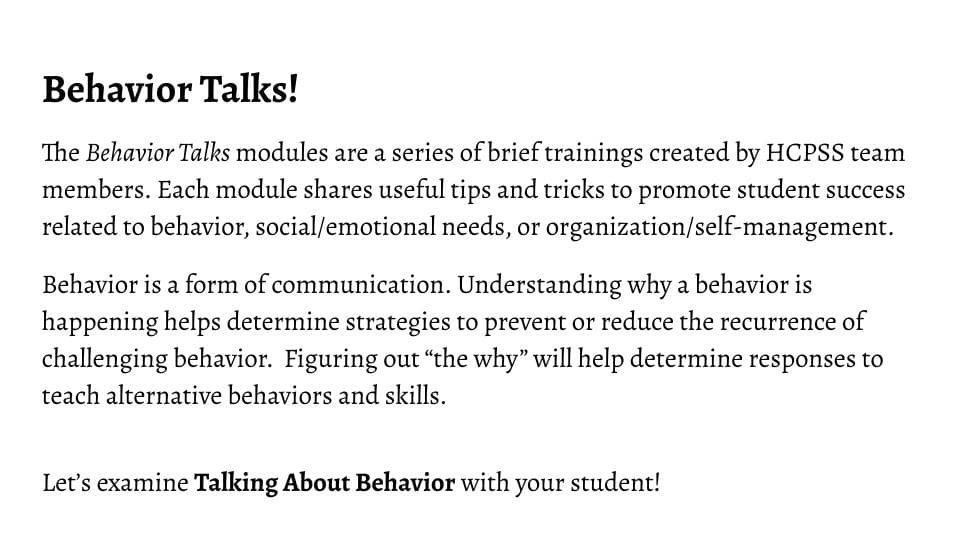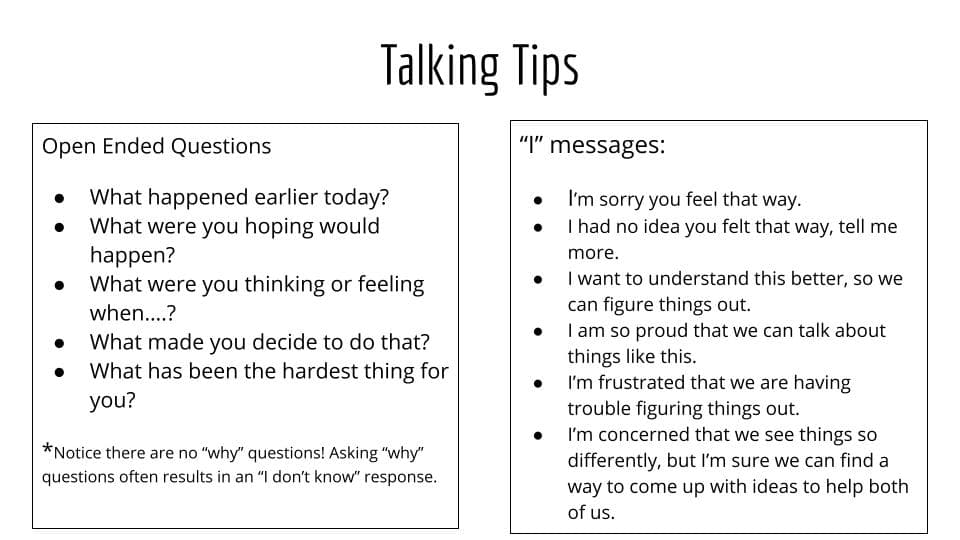Talking About Behavior
Transcript

Behavior Talks: Talking About Behavior
Welcome to Behavior Talks. This module suggests strategies for talking about challenging behavior with your student.

About Behavior Talks
The Behavior Talks modules are a series of brief trainings created by HCPSS team members. Each module shares useful tips and tricks to promote student success related to behavior, social/emotional needs, or organization/self-management.
Behavior is a form of communication. Understanding why a behavior is happening helps determine strategies to prevent or reduce the recurrence of challenging behavior. Figuring out “the why” will help determine responses to teach alternative behaviors and skills.
Let’s examine Talking About Behavior with your student!

Outcomes
In this video you will learn about the C.A.L.M. approach. You will learn about how to effectively implement strategies and learn tips and tricks to encourage a successful discussion.

The C.A.L.M. Approach
The C.A.L.M. approach is a collection of strategies compiled by HCPSS staff to provide a simple way for caregivers to remember to remain calm when talking to students about behavior. These strategies will help you communicate with your student in a positive, supportive manner when addressing challenging behavior. It can be difficult to talk about challenging behavior due to heightened emotions, unwillingness to listen empathically, or the lack of problem solving from past attempts, making it seem like a “broken record” to try again. There are many ways to talk about challenging behavior but C.A.L.M. is an easy acronym to remember some important strategies to make the interaction with your student successful. It may be helpful to think of the C.A.L.M. approach strategies as interchangeable versus sequential, in that you can start and revert back to any strategy you find most applicable in the conversation.

The C.A.L.M. Approach: A Collection of Strategies
The C.A.L.M. approach is an easy-to-remember acronym for strategies to talk with your student about their challenging behavior.
- The C in C.A.L.M stands for creating an opportunity to talk with your student about the behavior.
- The A stands for Ask about the challenging behavior you want to talk about.
- The L stands for listening with empathy and having an open mind about others’ point of view.
- The M stands for making a plan with your student, problem solving and reflecting about what to do next time.

CREATE
Let’s break down this approach. The C stands for Creating an opportunity to talk. You will want to find a good time when emotions are calm for both you and your student. Find a space that allows you to talk in private and is free of distractions. Avoid conversations during heightened emotions because it might have a negative impact on your relationship. Ask yourself, “Am I calm?” “Is my student calm?” If not, try calming strategies such as taking 3 deep breaths, counting to ten, or taking a short walk. Avoid distractions, such as having the TV on, so that both you and your student can be present in the moment. Start on a positive note to set the tone for a more comfortable conversation.

Create: What the Caregivers Say
Here are some examples of how to start once you’ve created an opportunity for a conversation. “That football game was a good one!” “Thanks for helping me with the groceries.” “You really had a good idea for dinner tonight.” “I’m glad we have some time to figure out what happened earlier.” Or “I like how we both used strategies to get calm.” These examples create a positive beginning for a conversation between you and your student.

ASK
The A stands for “Ask about the challenging behavior”. When talking with your student, the goal of the conversation should be to get to the root cause about their behavior and this can be accomplished by asking probing questions to your student. Think about your student’s age and level of communication. For example, with a younger student you might use pictures or gestures to communicate their emotions. If your student uses a communication device, use that to help facilitate the conversation.
Avoid the “blame game” or finger pointing, or speaking for them. While it is important to share your side of the experience and model appropriate behaviors, we want to make sure your student is using this conversation as an opportunity to reflect, learn, and grow.
Make sure to walk away from the conversation knowing what caused the behavior in order to see patterns regarding your student’s behavior.

Ask: What the Caregivers Say
The types of questions and statements you make during the conversation depends on the incident. Here are just a few examples:
*Ask open-ended questions such as “What happened earlier? “What were you thinking when that happened” “ What were you hoping would happen” “What did you want when you did that?” “Who was affected by what happened?”
*Avoid questions beginning with the word “Why.” Often when asked “Why did you do this”, it sounds accusatory, so the response may be a negative one. Additionally, a “Why” question can result in an “I don’t know” response from your student, giving you no insight into what your student is thinking or feeling.

Ask: What the Caregivers Say and Do
*Make “I” statements about yourself. For example: “I feel upset because I need to know that you’re safe.” “I get frustrated because I want you to be on time for school.”
*If students are struggling to articulate their feelings, provide cue cards, sentence starters, or say that you can guess for them and they’ll tell you if you’re right or wrong, hot or cold.
*Show and model with pictures, language about emotions they have learned at school or with a therapist, or their communication device to help with your student’s understanding.

LISTEN
The L stands for Listen. Specifically, listening with empathy. It is important to listen to what your student is saying and try to understand where they are coming from. See things from their perspective. For effective listening, be present during the conversation by giving your full attention, not checking your phone or working on your computer.
Actively listening is important because it helps validate your student’s feelings and makes them feel valued. Avoid distractions when listening to your student as well as just waiting for your turn to speak. Be engaged with your student while listening.

Listen: What Caregivers Do
Use active listening strategies such as giving eye contact, nodding your head, and giving the occasional “mhmm” or “ I see.” Repeat back important statements, such as, “So I heard you say” or “What I’m hearing you say is…”
You don’t have to agree, but do acknowledge what they are saying so that your student feels supported during the conversation. If during the conversation your student is making argumentative comments, be mindful of making simple statements that acknowledge what they are saying while still continuing the conversation. For example, if your student accuses or blames you, you can make acknowledging one line statements that can end the conflict, preserve everyone’s dignity, and continue the conversation. Examples of one line statements include, “I’m sorry that you feel that way,” “You present an interesting opinion,” or “Wow, I had no idea you felt that way, tell me more.” Avoid getting into a power struggle so that you can keep communication lines open.

MAKE A PLAN AND REFLECT
The M stands for Make a Plan & Reflect. After you have addressed the behavior, you make a plan and reflect on how to prevent future instances of challenging behaviors. You can problem solve with your student about which behaviors you would want them to do instead of the challenging behavior. Be sure to reflect with your student on why the behavior happened in the first place. Think about what you can do, as the adult, to approach things differently in the future. Avoid ignoring the problem behavior or thinking it will go away.

Make a Plan and Reflect: What Caregivers Can Do
Avoid telling your student what to do such as, “You need to apologize”, instead ask for their ideas on next steps. For example, maybe the student would benefit from using a simple visual schedule so they can keep track of their new routine, or maybe the student practices asking for help or asking for breaks during homework assignments.
If they are having conflicts with a sibling or peer, teach them to ask for an adult, to walk away, or take a break to calm down. These ideas might avoid instances of building up frustration, shutting down, or acting out verbally or physically with family members.
Be sure to find ways to provide solutions to problems before they become big problems, and come to agreements about next steps. Be sure to listen to your student’s ideas during this time, and realize that sometimes ideas for change sound good, but may need to be modified once you get started.

Why is the C.A.L.M. Approach helpful?
Positive communication can only occur when everyone is calm, focused on problem solving, willing to listen to one another with empathy, working together to avoid future conflict, and reflecting on one’s own behavior. Remember, you are modeling and teaching positive communication strategies!
The intent of C.A.L.M. is to provide you with an acronym to think of some strategies to aid in your conversation with your student. While we think creating a calm environment should be a helpful jumping off point, all strategies described are not sequential nor are they all required. C.A.L.M. is just a helpful reference to think of ways to change your behavior to break a cyclical pattern of ineffective communication with your student.

C.A.L.M. Tips
Here is a summary of the C.A.L.M approach for talking about behavior with your student titled “C.A.L.M. Tips”. The first column on the left identifies the acronym for C.A.L.M. The middle column provides tips to try for Create, Ask, Listen, and Make a Plan and Reflect. The last column on the right summarizes what to avoid when using this approach. A copy of this summary can be found in the Behavior Talks Additional Resources page.

Talking Tips
This summary is “Talking Tips”. The first column provides examples of open ended questions, such as “What happened earlier today?” The second column provides examples of the “I” messages. A copy of this summary can be found in the Behavior Talks Additional Resources page.

References
Thank you for watching! We hope that you found this video helpful. For additional resources please visit see the Behavior Talks Additional Resources page.